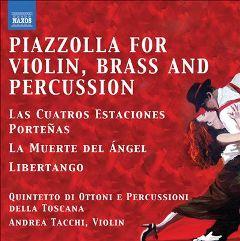Astor Piazzolla - Tangos for Violin, Brass Quintet and Percussion (2011)
Astor Piazzolla - Tangos for Violin, Brass Quintet and Percussion (2011)

1. Violentango (arr. D. De Sena for brass quintet and percussion) 00:04:26 2. Amelitango (arr. D. De Sena for brass quintet and percussion) 00:04:07 3. Tristango (arr. D. De Sena for brass quintet and percussion) 00:05:32 Las 4 Estaciones Portenas (The 4 Seasons in Buenos Aires) (arr. D. De Sena for violin, brass quintet and percussion) 4. No. 1. Verano Portena 00:04:57 5. No. 2. Otono Portena 00:04:30 6. No. 3. Invierno Portena 00:05:47 7. No. 4. Primavera Portena 00:04:18 8. Undertango (arr. D. De Sena for brass quintet and percussion) 00:04:30 9. Novitango (arr. D. De Sena for brass quintet and percussion) 00:03:49 10.Histoire du Tango (History of the Tango): I. Bordel 1900 (arr. D. De Sena for violin, brass quintet and percussion) 00:04:02 11.La Muerte del Angel (arr. D. De Sena for violin, brass quintet and percussion) 00:03:19 12.Meditango (arr. D. De Sena for brass quintet and percussion) 00:06:15 13.Ave Maria (arr. D. De Sena for violin, brass quintet and percussion) 00:02:42 14.Oblivion (arr. D. De Sena for violin, brass quintet and percussion) 00:03:49 15.Libertango (arr. D. De Sena for violin, brass quintet and percussion) 00:02:06 Andrea Tacchi, violino Quintetto di Ottoni Percussioni della Toscana
The music of Argentine tango-classical fusion musician Astor Piazzolla has been played by an enormous variety of ensembles, going back to the days of Piazzolla himself. Most groups try to replicate the sounds of Piazzolla's own quintets (or other medium-sized groups), making strings stand in for the frictive quality of Piazzolla's own bandoneón, for example. Few have departed from the source material as thoroughly as does Italy's Tuscan Brass and Percussion Quintet, which divorces the rhythmic content of Piazzolla's music from the tonal content and assigns it to the percussion players. The rest goes to a group of brasses, with a violin present in some of the numbers to take prominent solos. The arrangements tend to abstract the rhythm, which somehow loses its tango quality as it is split from Piazzolla's extended minor harmonies. The violin's biggest workout comes in Las cuatro estaciónes porteñas (The Buenos Aires [Port City] Four Seasons), where the arrangement by Donato de Sena is based, without credit, on the version of the work by Russian composer Leonid Desyatnikov; the music includes quotations from Vivaldi's Four Seasons, and as these morph into the somewhat jazz-like Piazzolla renderings you have to stop and give credit to the musicians for the sheer imagination of the whole project. This odd conception is emphatically not a good place to start with Piazzolla, but those already hooked may find it instructive to discover just how far his music can be pushed. ---James Manheim, Rovi
download: uploaded yandex 4shared mediafire solidfiles mega filecloudio nornar ziddu
Zmieniony (Czwartek, 13 Marzec 2014 21:26)








